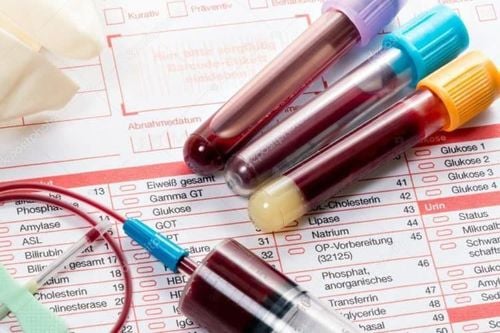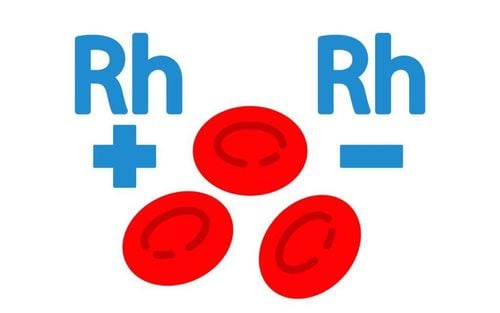This is an automatically translated article.
Progesterone has a role in regulating the menstrual cycle; help fertilize eggs; protect the fetus during pregnancy and support the development of the mammary glands during pregnancy,... Therefore, the progesterone test is very important to monitor the health of the woman and the fetus.
1. Progesterone overview?
Progesterone is a hormone secreted in the second half of the menstrual cycle in a woman and is also one of the hormones that regulate and stimulate one or more bodily functions. Progesterone is mainly produced from the placenta, a woman's ovaries, and the adrenal glands.Progesterone has the following role:
Role in the menstrual cycle: Regulating the menstrual cycle and increasing body temperature when ovulating on the days of the menstrual cycle. Role in the process of fertilizing an egg: Progesterone has helped the lining of the uterus to grow and thicken to create the best conditions to receive an egg. Role in pregnancy: Prevent uterine contractions; Progesterone helps prevent premature birth, protects the fetus during pregnancy; supports the development of mammary glands during pregnancy and creates a cervical mucus plug to avoid the invasion of bacteria, while helping to increase arterial blood and glycogen in the uterine lining to ensure nutrients for the fetus. Therefore, if there is a lack of progesterone levels, it will cause menstrual disorders (may be irregular, or amenorrhea); cause uncomfortable symptoms in the first 3 months of pregnancy, there is a risk of adversely affecting the pregnancy and limiting the development of the mammary glands.

2. When to test for Progesterone?
Progesterone test is a serological test to quantify levels of secreted Progesterone. Progesterone levels begin to rise when an egg is released from the ovary, rise for a few days, and then continue to rise during pregnancy or decrease to begin the menstrual cycle.
If progesterone levels on the test do not rise and fall below baseline, then a woman may not ovulate or have regular periods. This can be the cause of female infertility. Therefore, the progesterone level should be tested when experiencing one of the following problems:
There are signs of difficulty conceiving: When testing progesterone will help women know if the ovulation cycle is abnormal or not. During pregnancy: Progesterone test is to check the health of the pregnant woman and the fetus. Menstrual disorders: Progesterone levels change throughout the menstrual cycle, when doing a test, if a person has a lower Progesterone level than the permissible level, it may be poor ovarian function.
Trắc nghiệm: Tìm hiểu về “bí mật” của các Hormone
Hormone hầu như quyết định tới toàn bộ các chức năng quan trọng của cơ thể. Nó “làm việc” miệt mài để phát tín hiệu và điều hòa sự hoạt động của các cơ quan trong cơ thể, mô cũng như tế bào nhất định. Để hiểu hơn về vai trò cũng như cách thức các hormone tác động lên cơ thể, bạn có thể làm bài trắc nghiệm sau đây.
Nguồn tham khảo: webmd.com
3. Progesterone test steps
3.1. Preparation before the test
Before having a progesterone test, you must stop taking any medications that contain estrogen or progesterone for 4 weeks before the progesterone test.
Do not have a test using radioactive substances within the past 7 days. Some tests such as: thyroid scan test, bone scan use radioactive tracer.
Inform the doctor about the first day of the last menstrual period and the nature of the menstrual cycle.

3.2. Progesterone test steps
Step 1: Y, the doctor will use an elastic band and wrap it around the upper arm to stop the blood flow. This makes the veins below the band larger for easier insertion of the needle into the vein.
Step 2: Clean the needle site with alcohol. Then, place the needle into the vein.
Step 3: Attach a tube to the needle to fill it with blood.
Step 4: Remove the bandage from the arm once enough blood has been drawn, then apply a gauze pad or cotton ball over the needle site when the needle is removed and then re-bandage.
For women who are having problems with their menstrual cycle or are unable to get pregnant, the progesterone test may require more than one blood sample to test.
4. How to Read Progesterone Test Results
After the Progesterone test results are available, the reading of the results is a factor to help the tester know whether the progesterone level is low, high or normal. The unit used to measure the level of progesterone in the blood is ng/mL.
How to read progesterone test results:
For women in the middle of their menstrual cycle: Progesterone levels range from 5 to 20 ng/ml. For women after menopause or in the early menstrual cycle: Progesterone levels less than or equal to 1 ng/ml. For women in the first 3 months of pregnancy: Progesterone levels range from 15-60 ng/ml. For women in the second trimester of pregnancy: Progesterone levels range from 25.6 to 89.4 ng/ml. For women in the last 3 months of pregnancy: Progesterone levels range from 48.4 to 42.5 ng/ml.

If in the case of high Progesterone levels (other than pregnancy) it may be due to: Congenital adrenal hyperplasia; Ovarian Cancer ; adrenal cancer.
If in case of low Progesterone test, it can be caused by: Miscarriage; preeclampsia, absence of ovulation; no period or ectopic pregnancy, stillbirth.
5. Method to balance progesterone levels
After the progesterone test, if the progesterone level is high or low, you need to take appropriate action to rebalance the amount of progesterone in the body. This will increase your chances of having a healthy pregnancy and make your life more comfortable. Here are some ways to balance progesterone levels in the body:
Using progesterone hormone therapy: Helps thicken the endometrium, increasing your chances of conceiving and having a healthy pregnancy; improve menstrual irregularities and irregular bleeding; relieve symptoms such as anger easily, improve morale, reduce the risk of osteoporosis, diabetes, sweating, vaginal dryness. Progesterone: Progesterone is used for a short time during each menstrual cycle. Taking the correct dose is important for it to be effective, so a dose should not be missed. Balanced estrogen and progesterone: For severe symptoms of menopause, a balance of estrogen and progesterone is needed. Because more estrogen than progesterone increases the risk of endometrial cancer. MORE
What is Progesterone? The role of Progestogen in the prevention of preterm birth Threats of preterm birth and preterm birth













